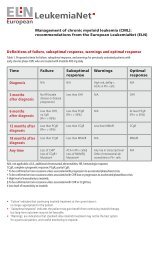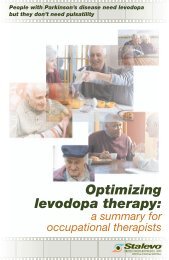IMPLANON IMPLANT FOR SUBDERMAL USE ... - epgonline.org
IMPLANON IMPLANT FOR SUBDERMAL USE ... - epgonline.org
IMPLANON IMPLANT FOR SUBDERMAL USE ... - epgonline.org
Create successful ePaper yourself
Turn your PDF publications into a flip-book with our unique Google optimized e-Paper software.
ORGANON EU SmPC<br />
RA 0450 EU S6 (REF 6.0) FINAL<br />
9<br />
<strong>IMPLANON</strong><br />
<strong>IMPLANT</strong> <strong>FOR</strong> <strong>SUBDERMAL</strong> <strong>USE</strong><br />
4.3 Contraindications<br />
• Active venous thromboembolic disorder.<br />
• Progestagen-dependent tumors.<br />
• Presence or history of severe hepatic disease as long as liver function<br />
values have not returned to normal.<br />
• Undiagnosed vaginal bleeding.<br />
• Hypersensitivity to the active substance or to any of the excipients of<br />
Implanon ® .<br />
4.4 Special warnings and special precautions for use<br />
4.4.1 Warnings<br />
If any of the conditions / risk factors mentioned below is present, the benefits<br />
of progestagen use should be weighed against the possible risks for each<br />
individual woman and discussed with the woman before she decides to start<br />
with Implanon ® . In the event of aggravation, exacerbation or first appearance<br />
of any of these conditions, the woman should contact her physician. The<br />
physician should then decide on whether the use of Implanon ® should be<br />
discontinued.<br />
NL0059686<br />
• The risk for breast cancer increases in general with increasing age. During<br />
the use of oral contraceptives (OCs) the risk of having breast cancer<br />
diagnosed is slightly increased. This increased risk disappears gradually<br />
within 10 years after discontinuation of OC use and is not related to the<br />
duration of use, but to the age of the woman when using the OC. The<br />
expected number of cases diagnosed per 10 000 women who use<br />
combined OCs (up to 10 years after stopping) relative to never users over<br />
the same period have been calculated for the respective age groups to<br />
be: 4.5/4 (16-19 years), 17.5/16 (20-24 years), 48.7/44 (25-29 years),<br />
110/100 (30-34 years), 180/160 (35-39 years) and 260/230 (40-44 years).<br />
The risk in users of contraceptive methods, which only contain<br />
progestagens, is possibly of similar magnitude as that associated with<br />
combined OCs. However, for these methods, the evidence is less<br />
conclusive. Compared to the risk of getting breast cancer ever in life, the<br />
increased risk associated with OCs is low. The cases of breast cancer<br />
diagnosed in OC users tend to be less advanced than in those who have<br />
not used OCs. The increased risk observed in OC users may be due to an<br />
earlier diagnosis, biological effects of the OC or a combination of both.<br />
Since a biological effect of hormones cannot be excluded, an individual
















